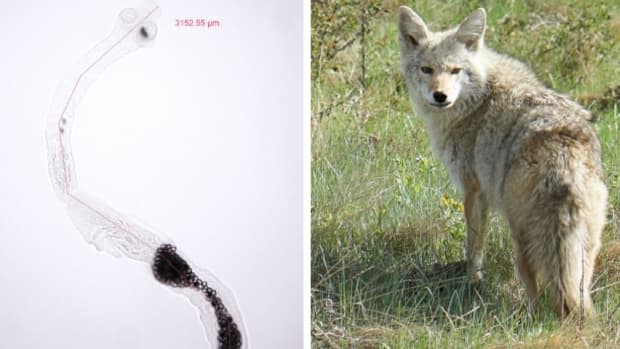Alberta now a 'hot spot' for tapeworm that can cause fatal tumours in humans, study cautions

Alberta is now a hot spot of a potentially deadly tapeworm passed from wild canines to humans, and many cases of the parasitic infection could be going undetected, warns an infectious disease specialist.
"Alberta is clearly the hot spot," said Stan Houston, a University of Alberta professor in the Faculty of Medicine & Dentistry and lead author of a new study detailing a recent cluster of alveolar echinococcosis (AE) cases in Alberta.
"There could be a number of people out there in the community incubating the disease that we haven't found yet but time will tell."
Houston's study, published in the American Journal of Tropical Medicine and Hygiene, details 17 cases diagnosed in Alberta between 2013 and 2020, including a man who died of surgical complications from the infection.
COVID has reminded us that diseases stemming from animals are potentially very important and that we should be paying attention. -Stan Houston, lead author
Before the recent surge in Alberta, only two human cases of the disease had been confirmed in North America — one in Manitoba in 1928 and another in Minnesota in 1977, Houston said.
"This remains a pretty rare disease but we should be paying attention to it," Houston said.
"It's been found in Saskatchewan and in B.C., but Alberta has had most of the cases."
AE is an infection caused by the European strain of a tiny intestinal tapeworm. It's believed the strain arrived in Canada through imported dogs, Houston said.
The parasite is often carried by wild canines, such as coyotes, but domestic dogs can also be a carrier.
Humans can acquire the infection by ingesting food or soil contaminated with worm eggs too small to see. In humans, the disease develops slowly and causes multiplying lesions in the body, usually in the liver.
Treatment involves surgery or a lifelong regimen of medication to keep the lesions in check. The disease is more severe in people who are immunocompromised. Without treatment, the infection is usually fatal.
Hard to spot, diagnose
Houston said the disease is difficult to spot and often misdiagnosed. It's also spreading quickly in the wild, especially among urban coyotes in Edmonton and Calgary.
"COVID has reminded us that diseases stemming from animals are potentially very important and that we should be paying attention," Houston said.
He suspects more cases will be identified following the pandemic.
"I am very concerned that we might see the surge continue to increase again," he said.
The patients detailed in the study include nine women and eight men, aged 19 to 78.
Six lived in urban areas and 14 kept dogs. Six were immunocompromised. Lesions were found in eight patients while undergoing unrelated medical screening.
This is an infection that has flown under the radar. - Scott Weese, infectious disease specialist
The 62-year-old who died was a dog owner from rural Alberta. As detailed in Houston's study, doctors believed the man had cancer and performed surgery to excise a tumour when they discovered a parasitic lesion. He suffered fatal complications from the surgery last year.
Houston's team is now involved in a new study, led by pathologists at the University of Alberta Hospital, examining samples of liver biopsies from patients who were misdiagnosed with cancer to look for previously undetected cases of the infection.
Scott Weese, an infectious diseases specialist at the Ontario Veterinary College, said people can guard against infection by washing their hands, getting their dogs treated for the parasite and ensuring garden produce is washed.
Weese said AE's long incubation period in humans — five to 15 years — means it can easily escape detection. He suspects there are many undiagnosed cases across Canada.
"This is an infection that has flown under the radar," he said. "We can assume it's more widespread than we know."

 Yahoo Finance
Yahoo Finance